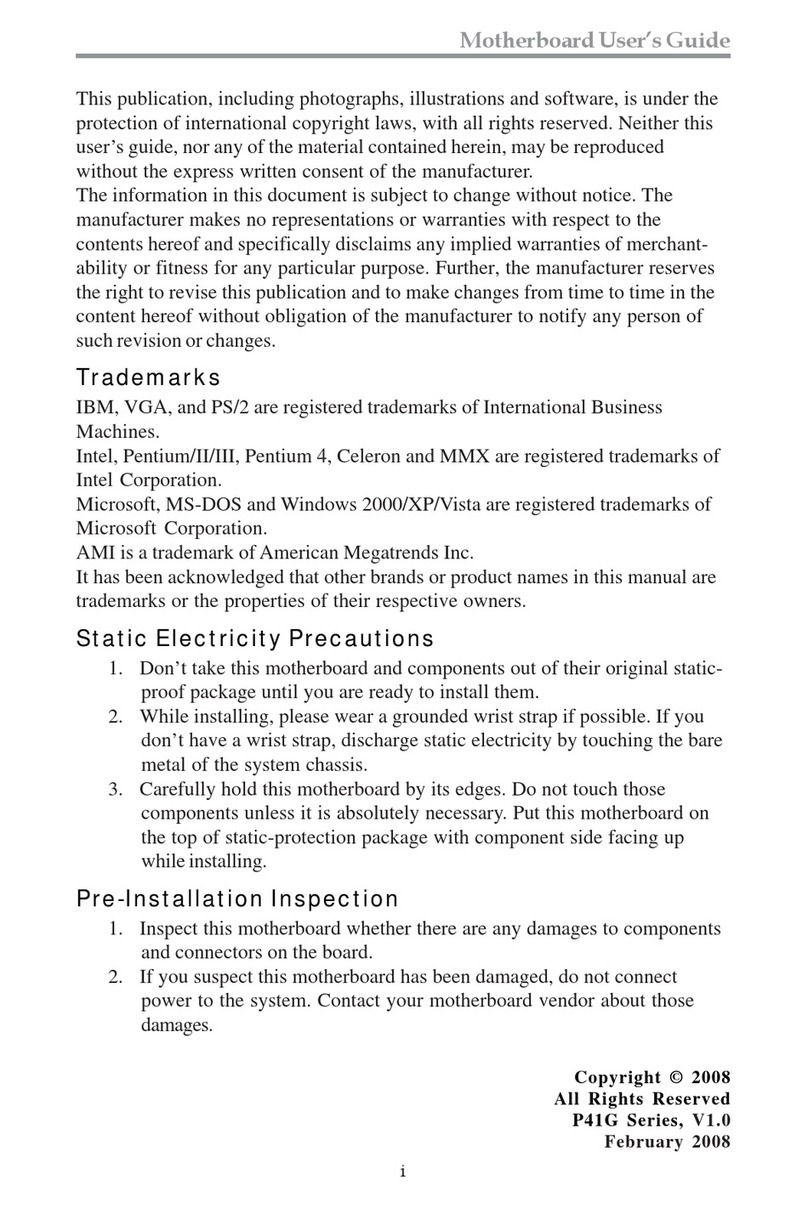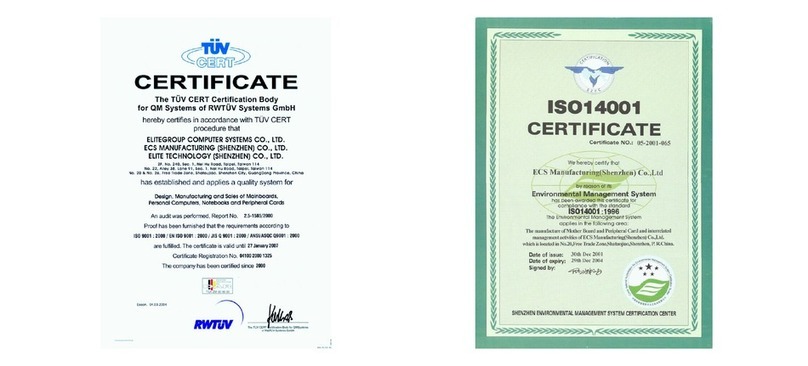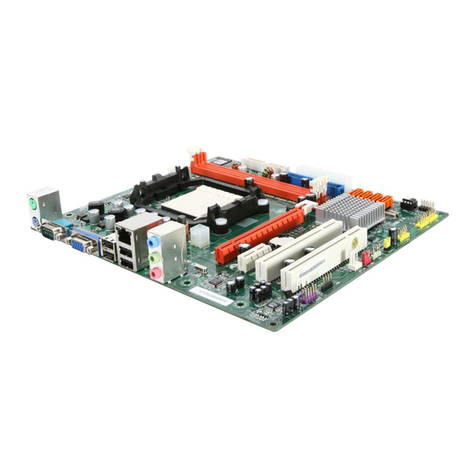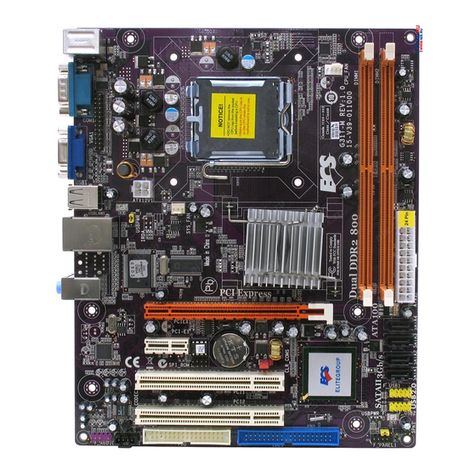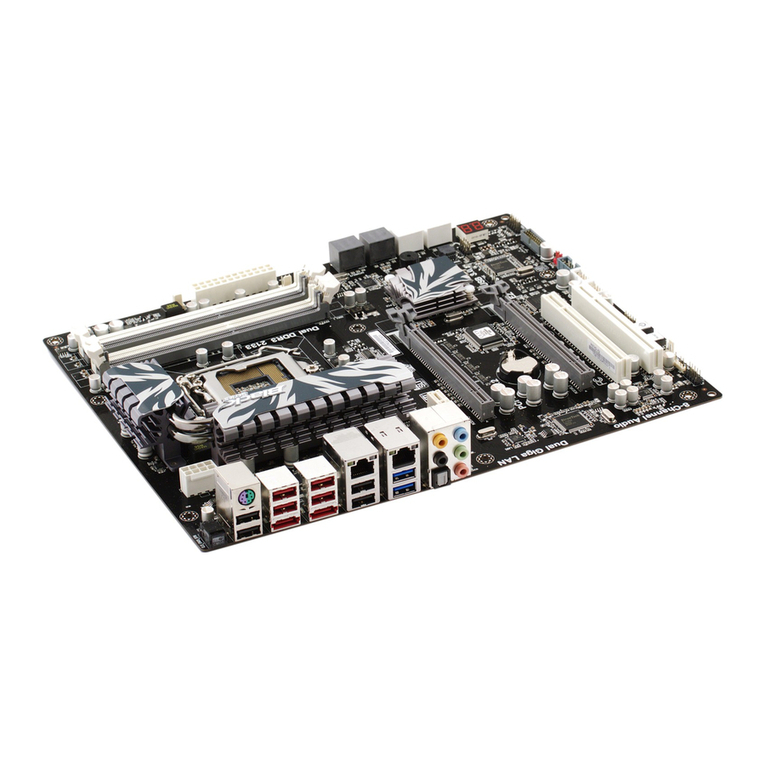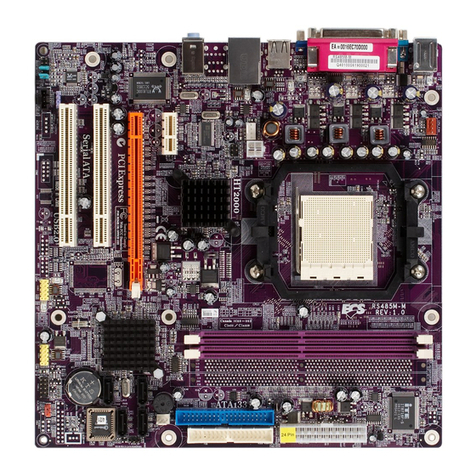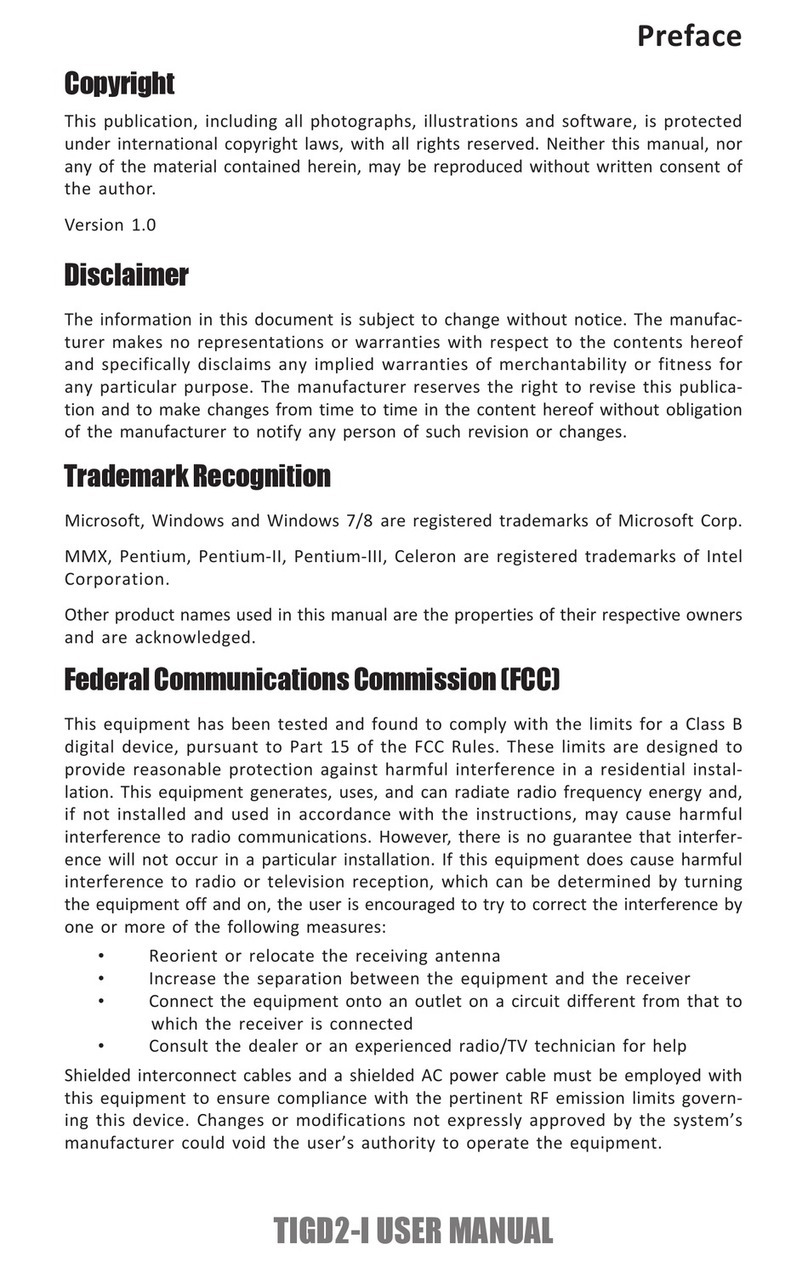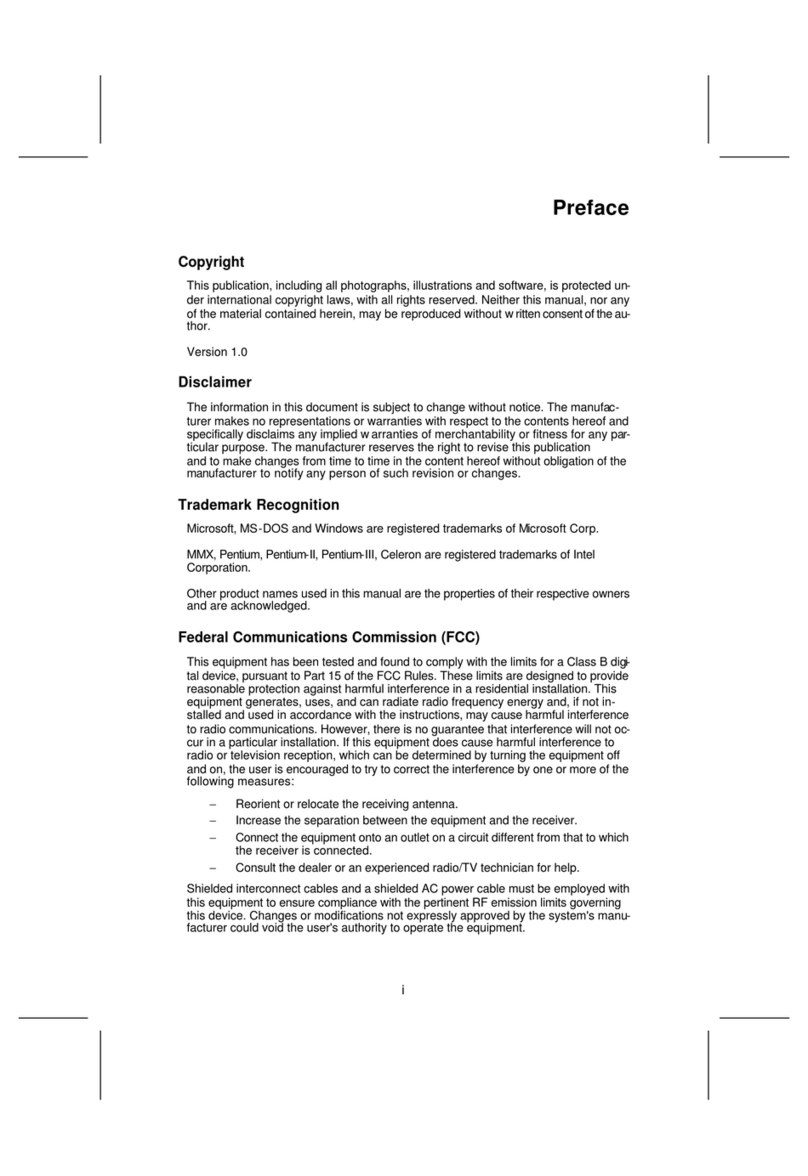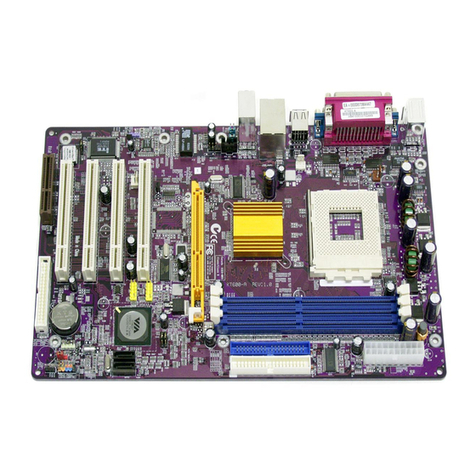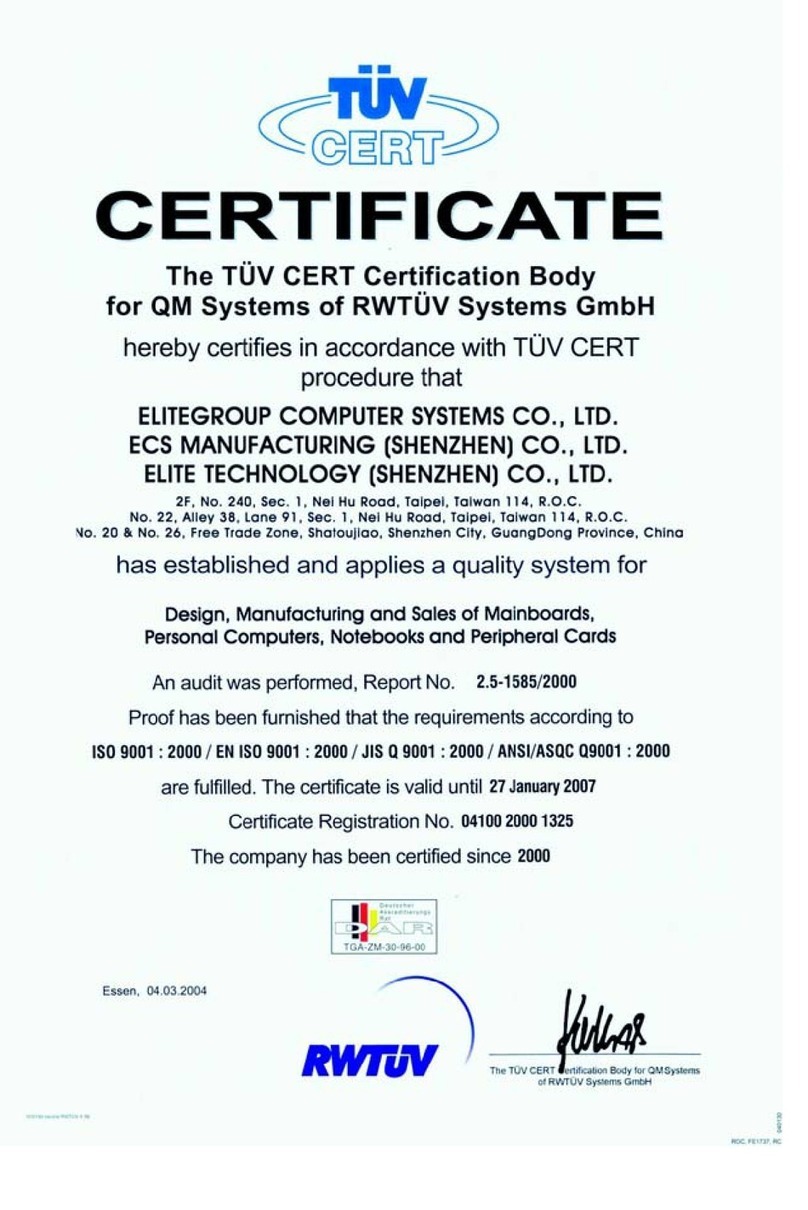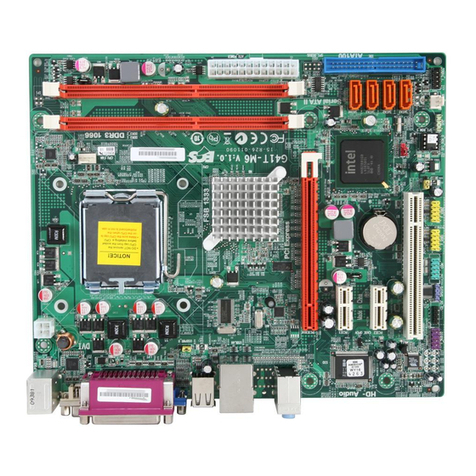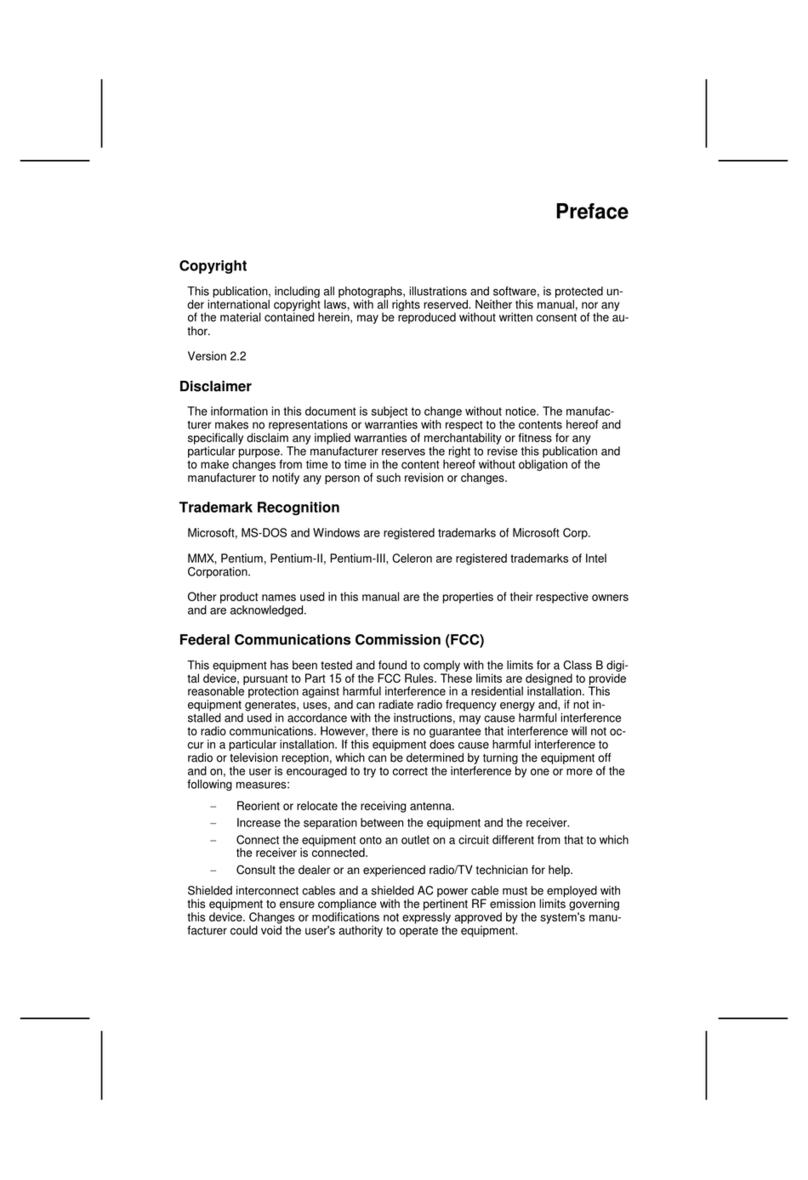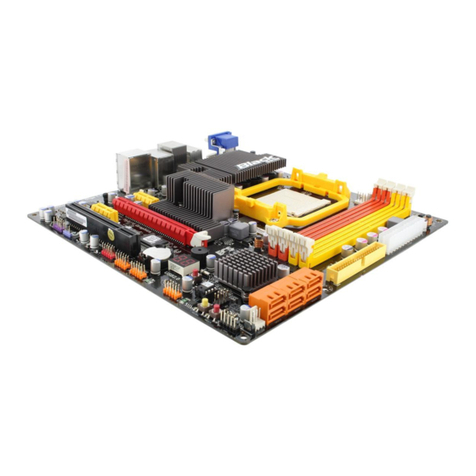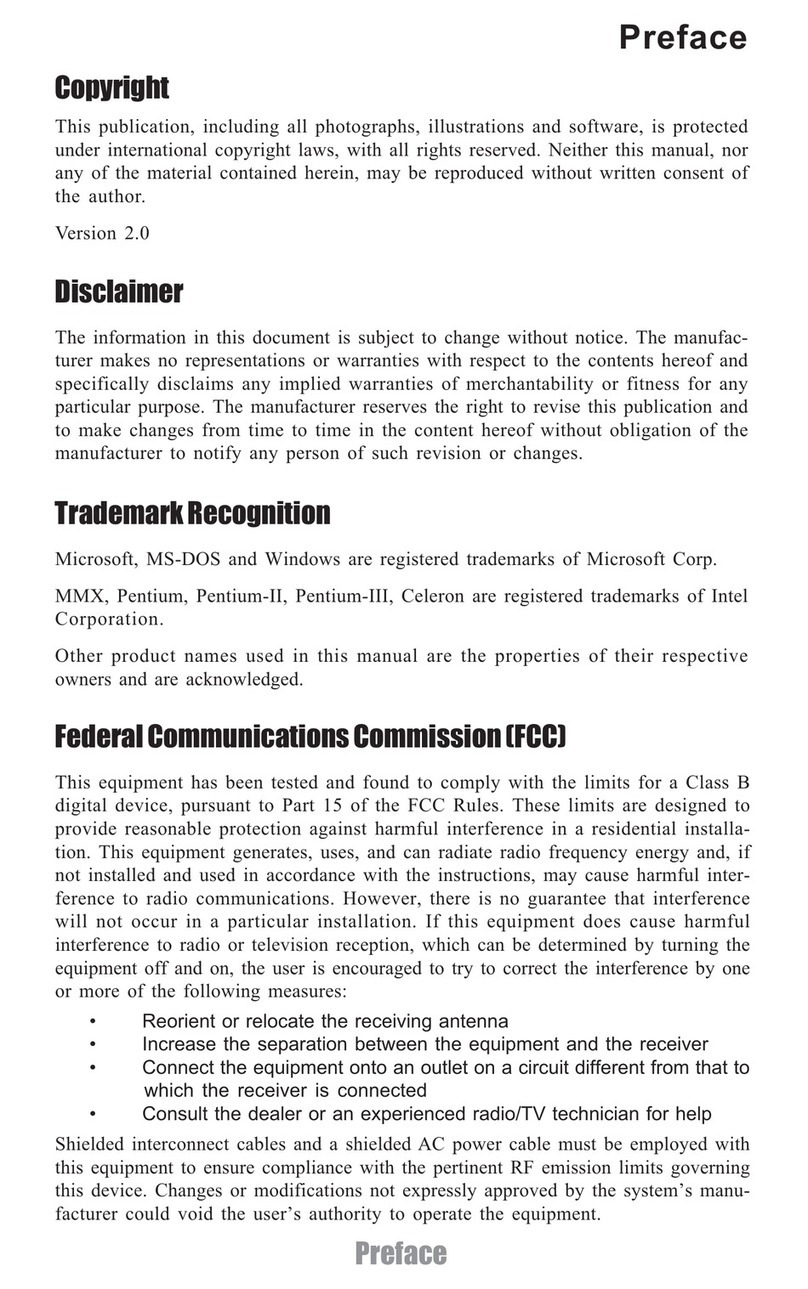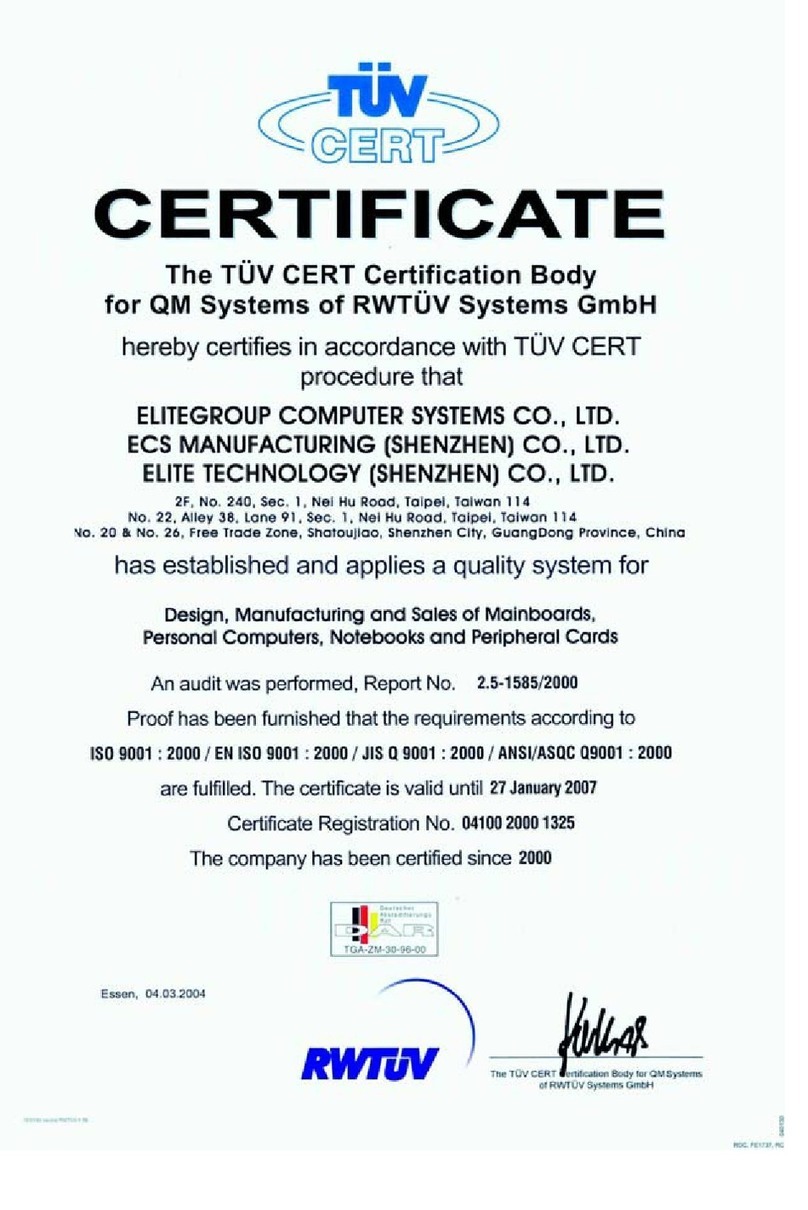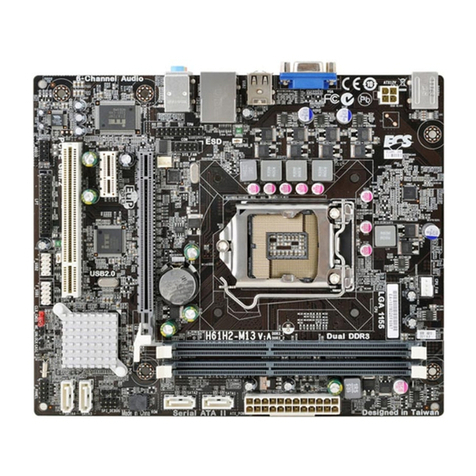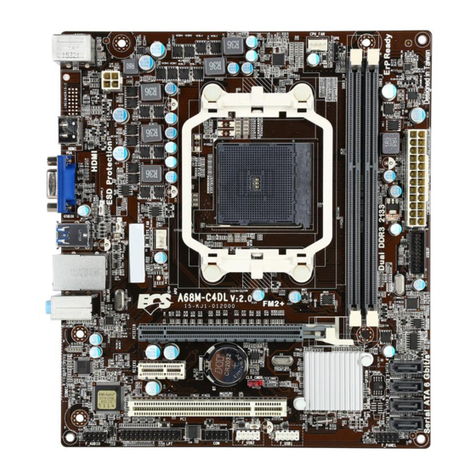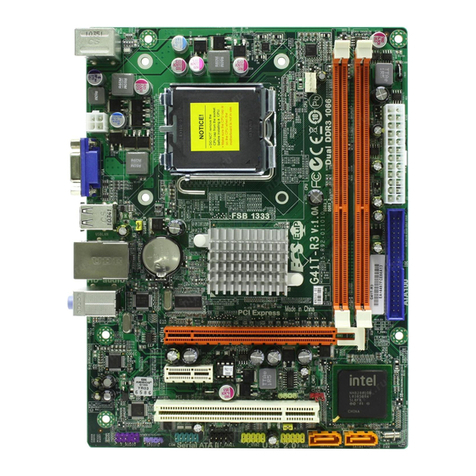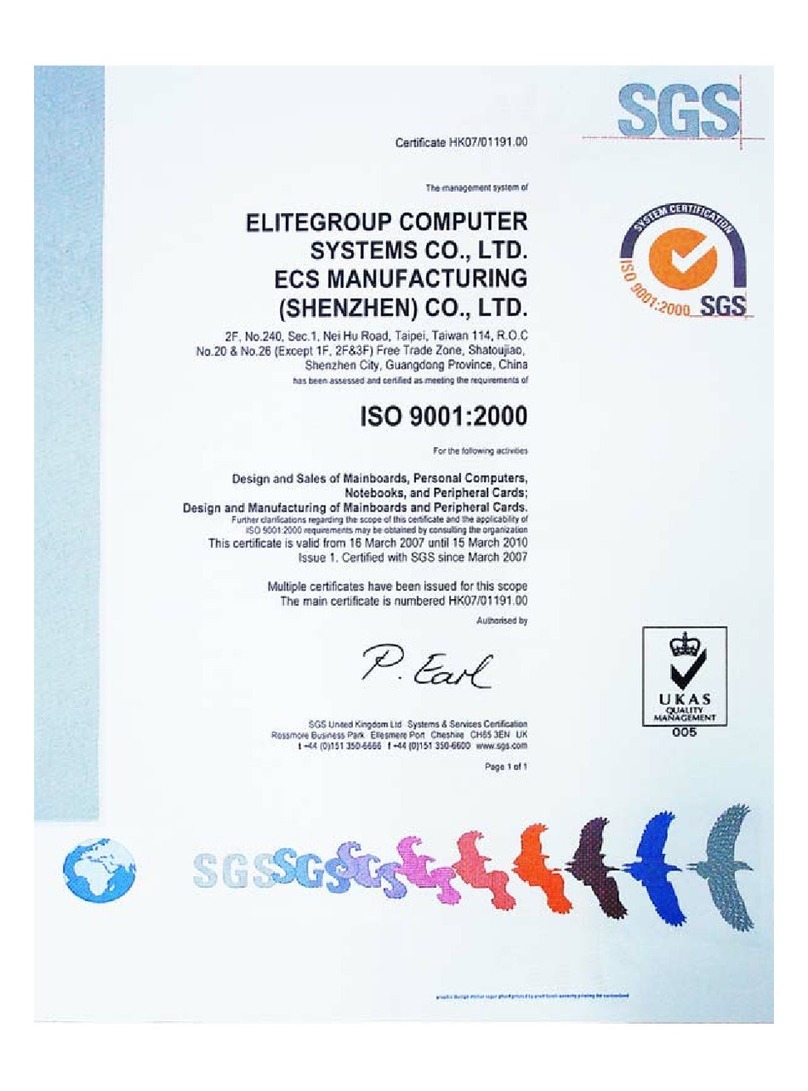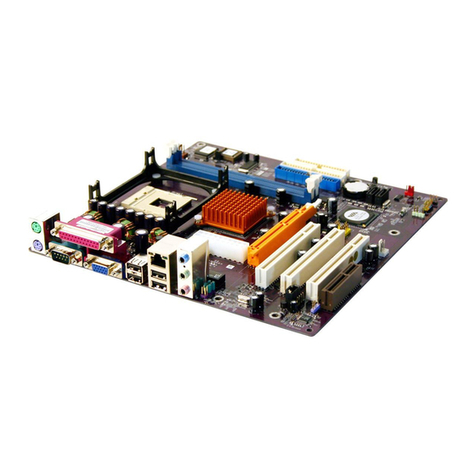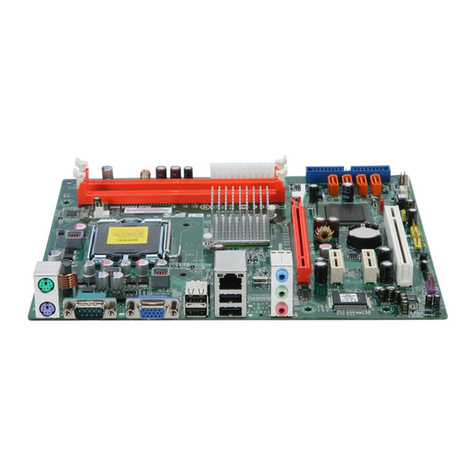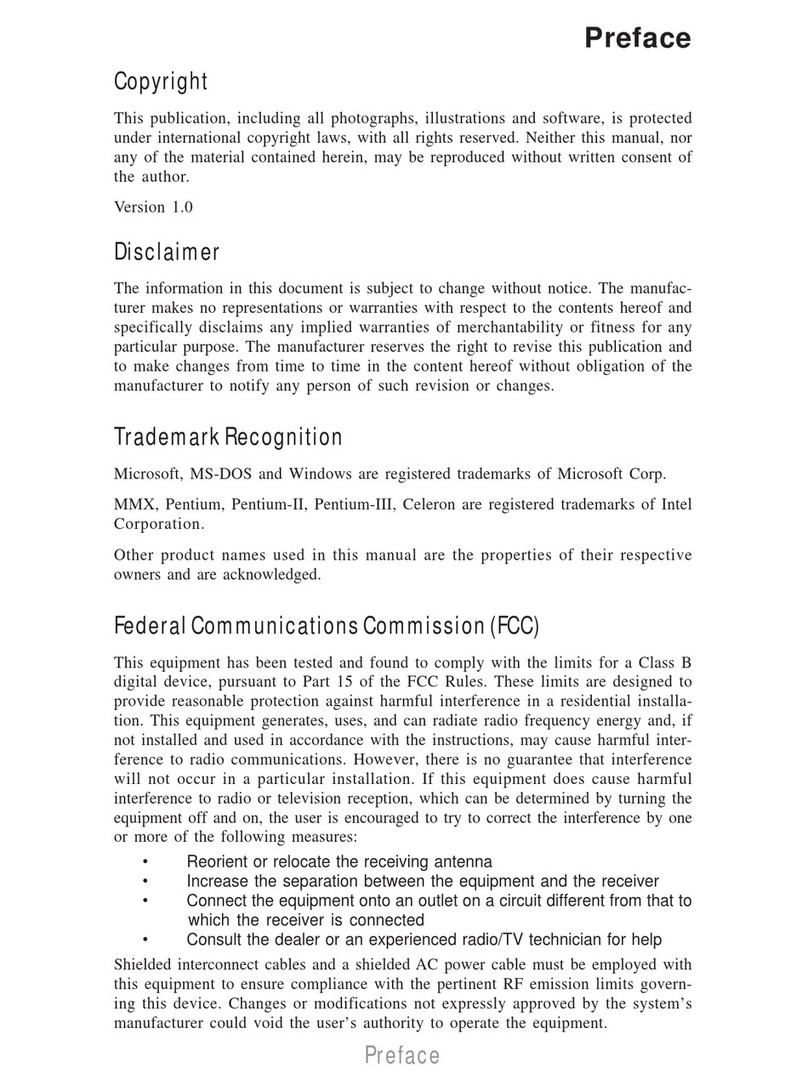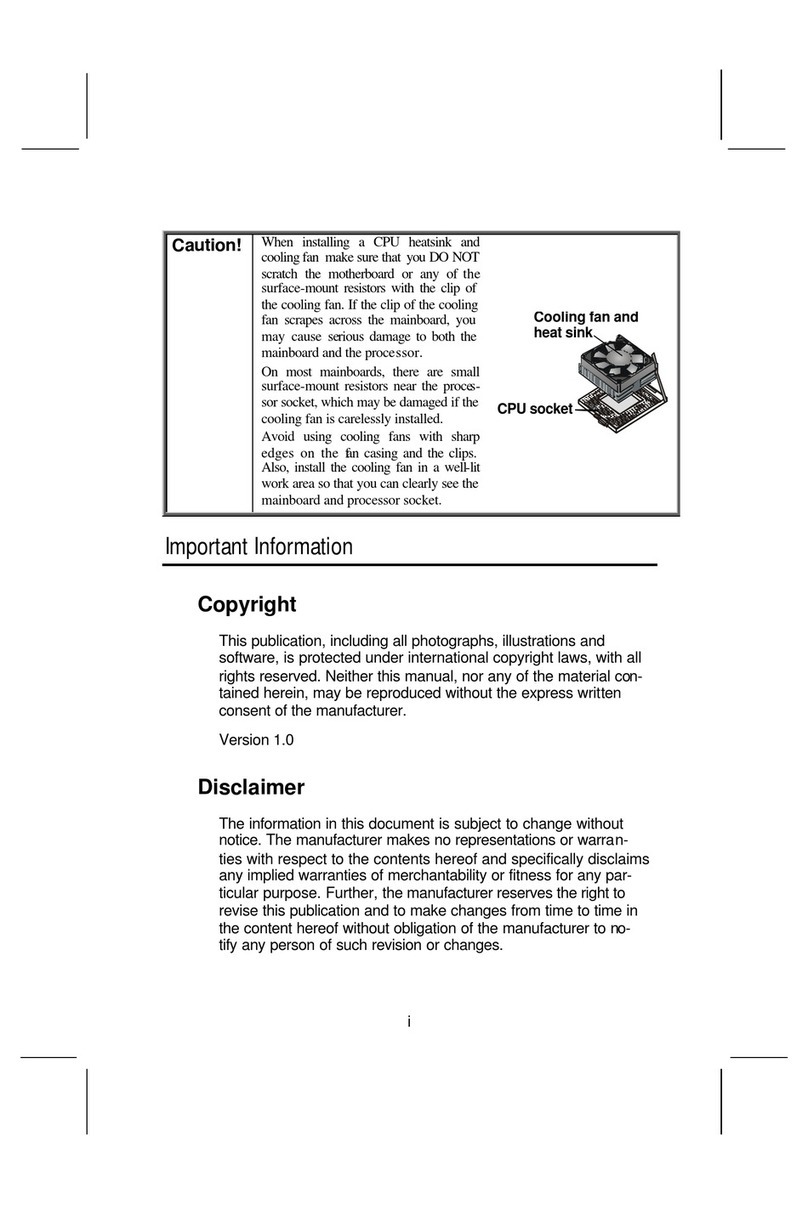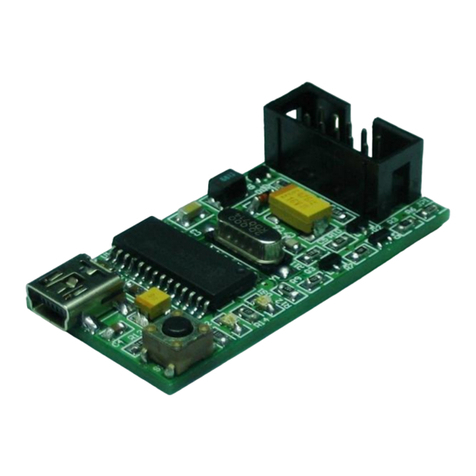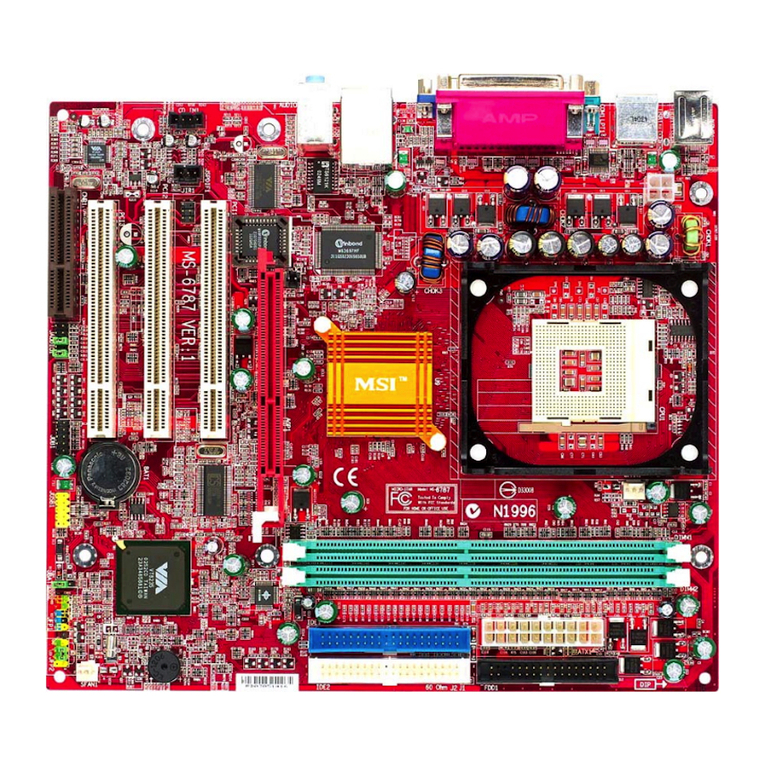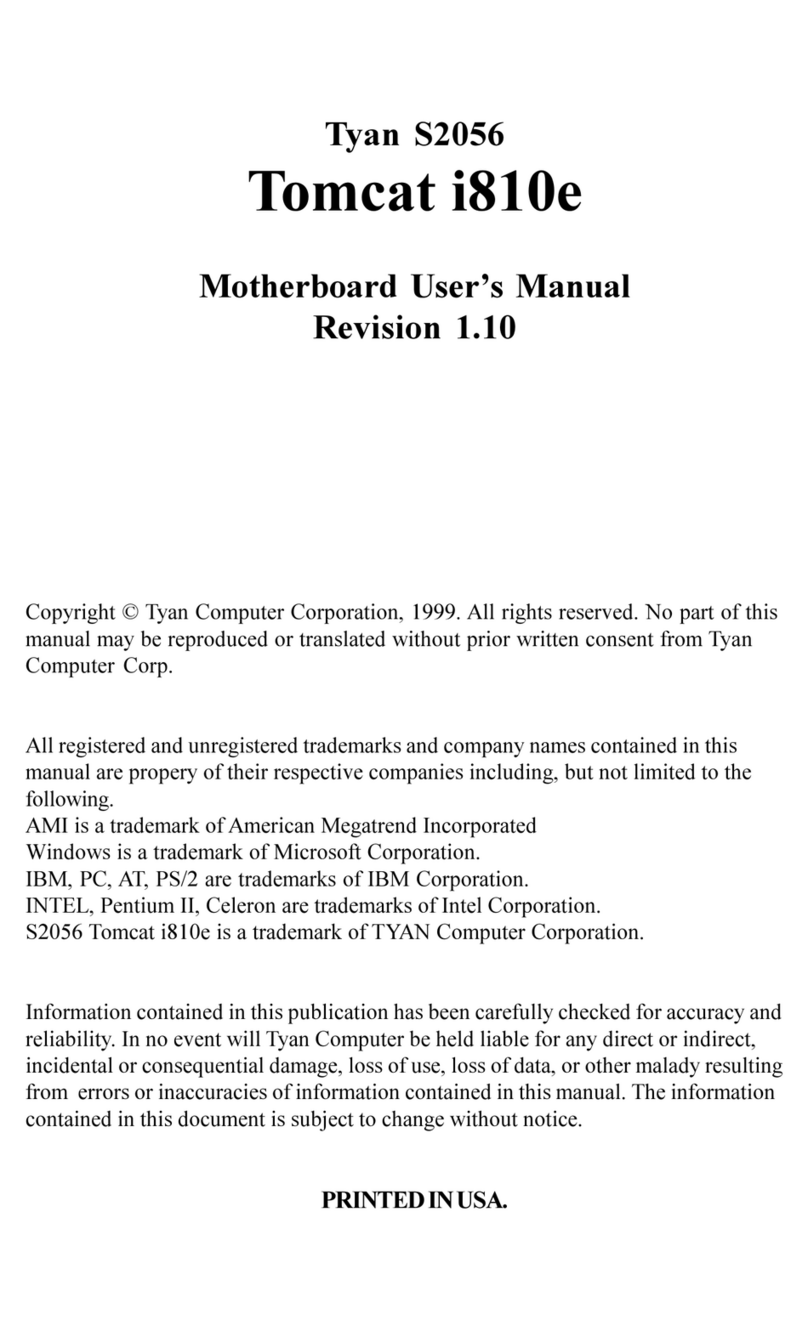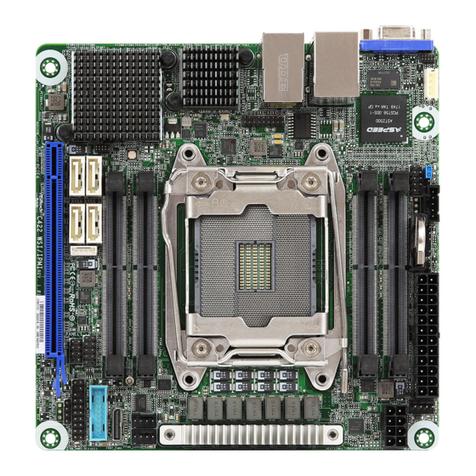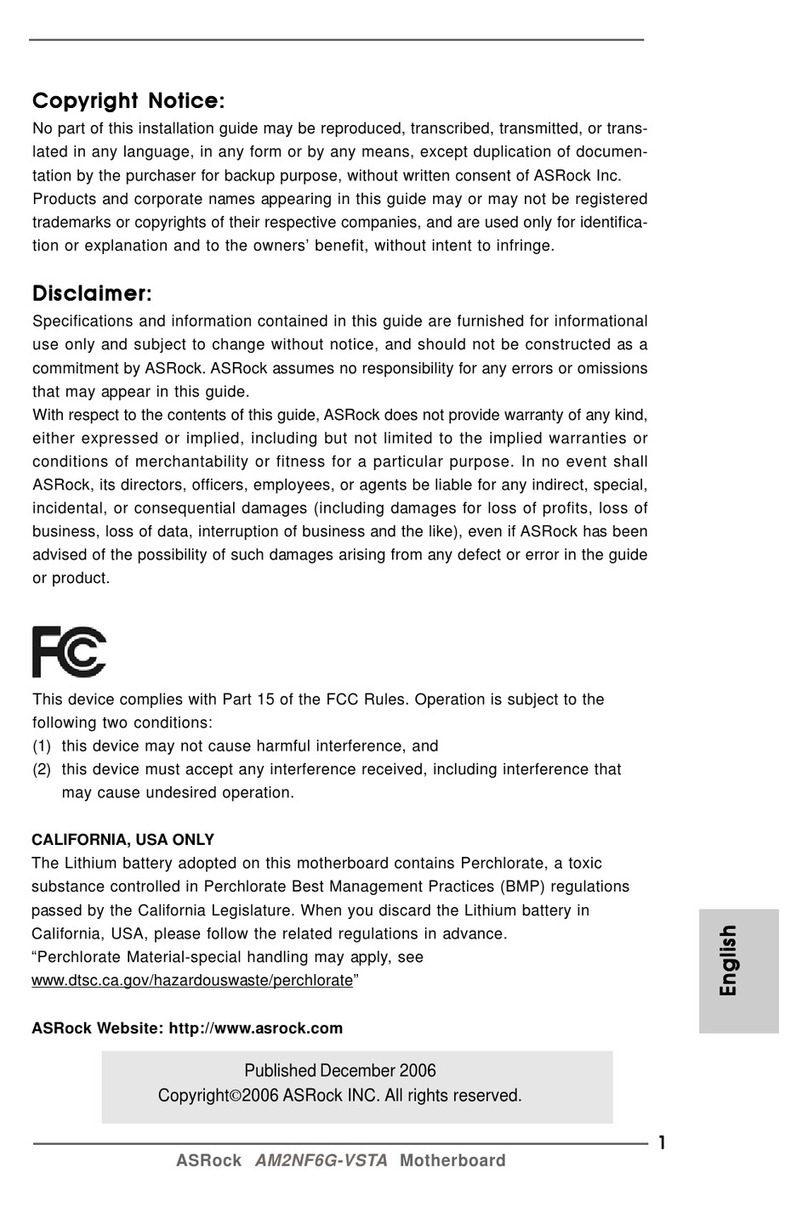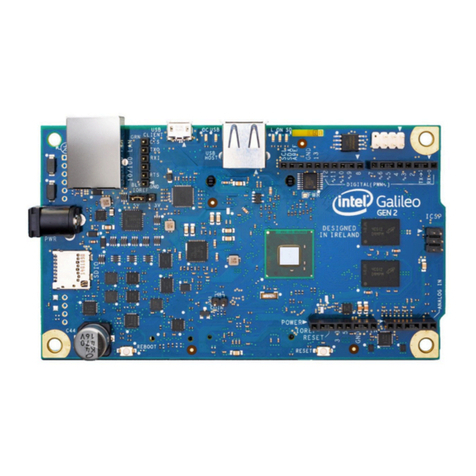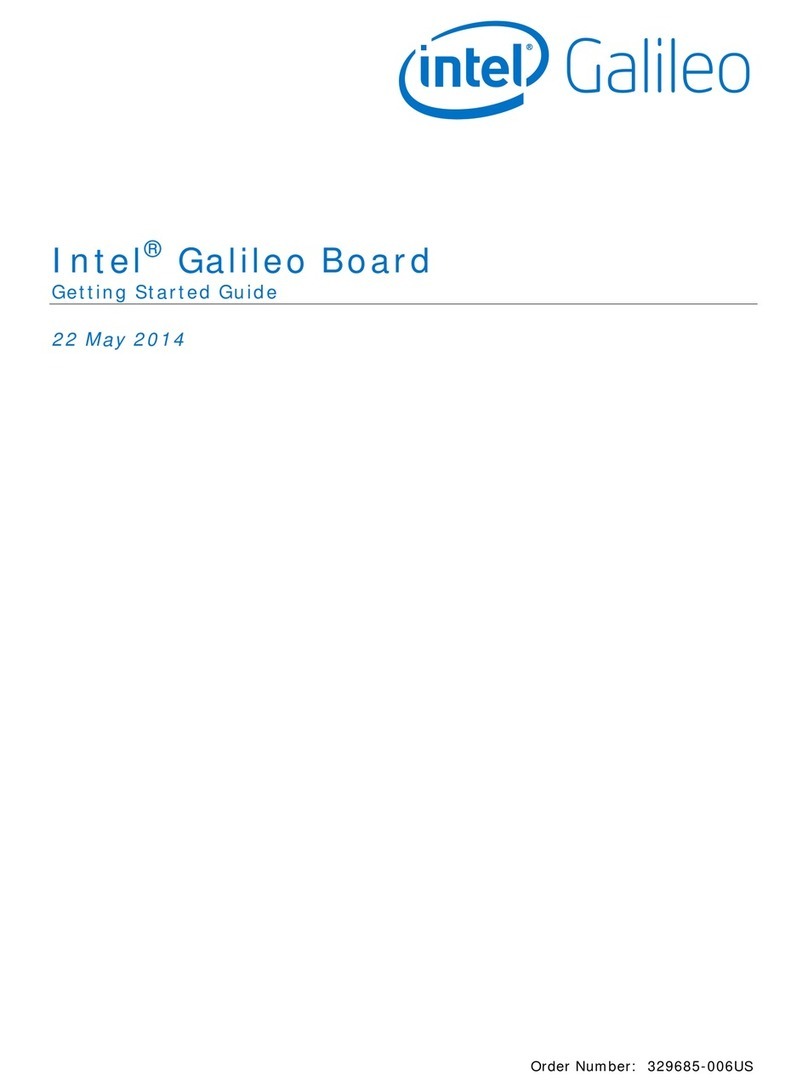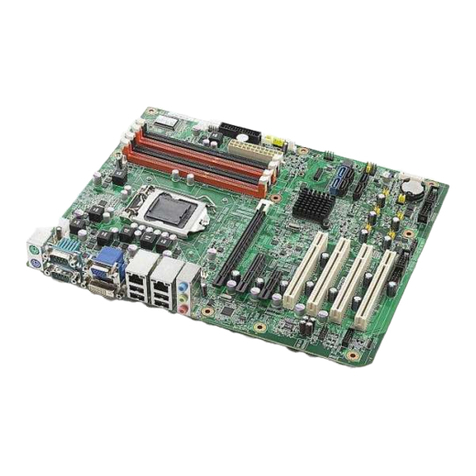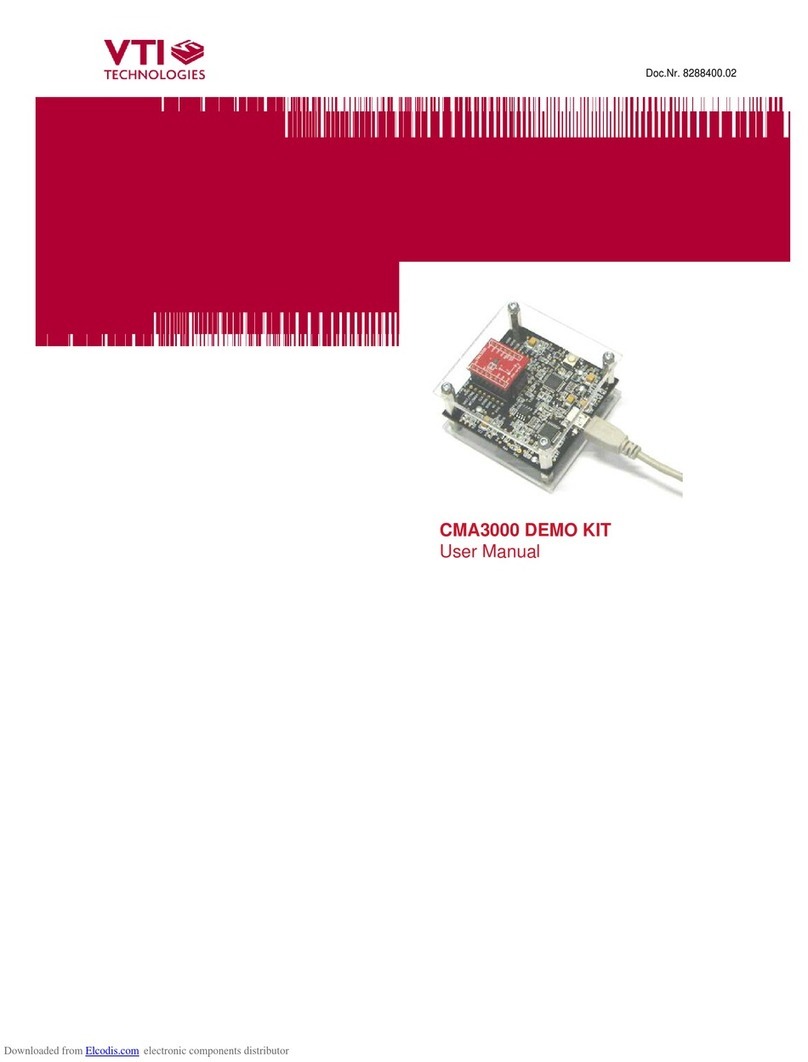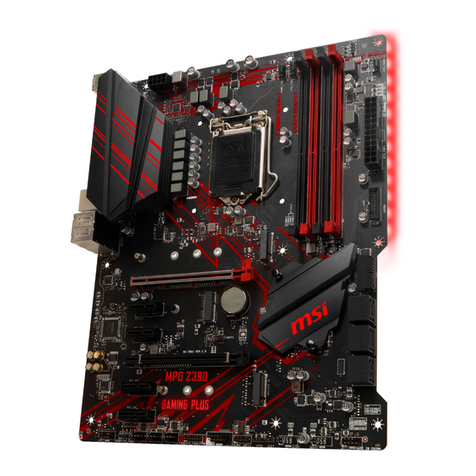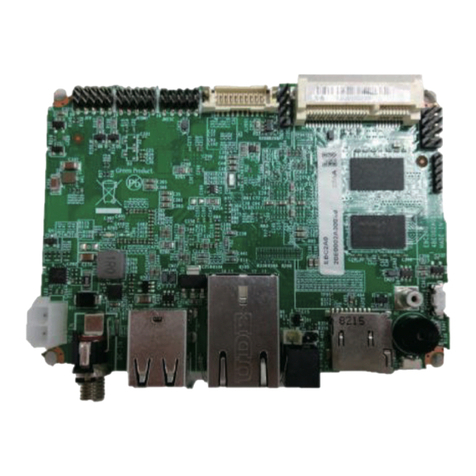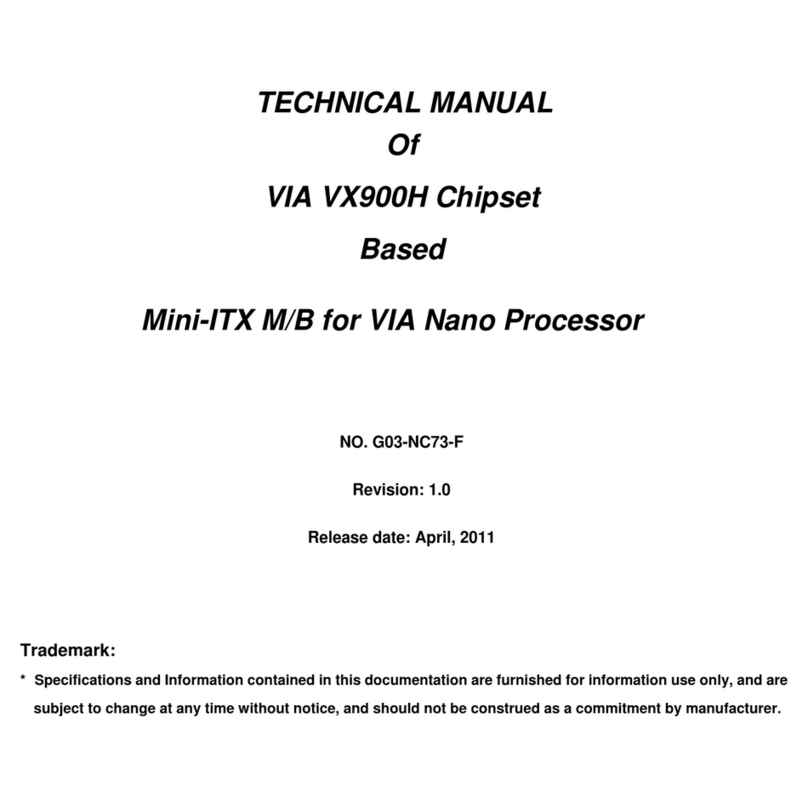ECS IC43T-A User manual

Preface
Preface
Copyright
This publication, including all photographs, illustrations and software, is protected
under international copyright laws, with all rights reserved. Neither this manual, nor
any of the material contained herein, may be reproduced without written consent of
the author.
Version 1.0
Disclaimer
The information in this document is subject to change without notice. The manufac-
turer makes no representations or warranties with respect to the contents hereof and
specifically disclaims any implied warranties of merchantability or fitness for any
particular purpose. The manufacturer reserves the right to revise this publication and
to make changes from time to time in the content hereof without obligation of the
manufacturer to notify any person of such revision or changes.
FederalCommunicationsCommission(FCC)
This equipment has been tested and found to comply with the limits for a Class B
digital device, pursuant to Part 15 of the FCC Rules. These limits are designed to
provide reasonable protection against harmful interference in a residential installa-
tion. This equipment generates, uses, and can radiate radio frequency energy and, if
not installed and used in accordance with the instructions, may cause harmful inter-
ference to radio communications. However, there is no guarantee that interference
will not occur in a particular installation. If this equipment does cause harmful
interference to radio or television reception, which can be determined by turning the
equipment off and on, the user is encouraged to try to correct the interference by one
or more of the following measures:
• Reorient or relocate the receiving antenna
• Increase the separation between the equipment and the receiver
• Connect the equipment onto an outlet on a circuit different from that to
which the receiver is connected
• Consult the dealer or an experienced radio/TV technician for help
Shielded interconnect cables and a shielded AC power cable must be employed with
this equipment to ensure compliance with the pertinent RF emission limits govern-
ing this device. Changes or modifications not expressly approved by the system’s
manufacturer could void the user’s authority to operate the equipment.
TrademarkRecognition
Microsoft, MS-DOS and Windows are registered trademarks of Microsoft Corp.
MMX, Pentium, Pentium-II, Pentium-III, Celeron are registered trademarks of Intel
Corporation.
Other product names used in this manual are the properties of their respective
owners and are acknowledged.

ii
Preface
DeclarationofConformity
This device complies with part 15 of the FCC rules. Operation is subject to the
following conditions:
• This device may not cause harmful interference, and
• This device must accept any interference received, including interfer-
ence that may cause undesired operation
CanadianDepartmentofCommunications
This class B digital apparatus meets all requirements of the Canadian Interference-
causing Equipment Regulations.
Cet appareil numérique de la classe B respecte toutes les exigences du Réglement sur
le matériel brouilieur du Canada.
AbouttheManual
The manual consists of the following:
Chapter 1
Introducing the Motherboard
Chapter 2
Installing the Motherboard
Chapter 3
UsingBIOS
Chapter 4
Using the Motherboard Software
Describes features of the
motherboard.
Go to Hpage 1
Describes installation of
motherboard components.
Goto Hpage 7
Provides information on us-
ing the BIOS Setup Utility.
Go to Hpage 25
Describes the motherboard
software
Go to Hpage 45

iii
TT
TT
TABLE OF CONTENTSABLE OF CONTENTS
ABLE OF CONTENTSABLE OF CONTENTS
ABLE OF CONTENTS
Preface i
Chapter 1 1
IntroducingtheMotherboard 1
Introduction......................................................................................1
Feature..............................................................................................2
MotherboardComponents.............................................................4
Chapter 3 25
UsingBIOS 25
Aboutthe SetupUtility................................................................25
The Standard Configuration...............................................25
Entering the Setup Utility....................................................25
Resetting the Default CMOS Values...................................26
UsingBIOS.....................................................................................27
Standard CMOS Setup.......................................................28
Advanced Setup..................................................................30
Advanced Chipset Setup.....................................................31
Chapter 2 77
77
7
Installing the Motherboard 7
SafetyPrecautions...........................................................................7
Choosinga ComputerCase............................................................7
Installingthe Motherboard in a Case...........................................7
CheckingJumperSettings..............................................................8
Setting Jumpers....................................................................8
Checking Jumper Settings....................................................9
Jumper Settings....................................................................9
Installing the Processor......................................................10
Installing Memory Modules................................................12
Expansion Slots....................................................................16
Connecting Optional Devices.............................................18
ConnectingI/ODevices...............................................................21
ConnectingCase Components....................................................22
Front Panel Header............................................................24
InstallingHardware........................................................................10
Installing a SATA Hard Drive............................................20

iv
Integrated Peripherals.......................................................32
Power Management Setup.................................................33
PCI/PnP Setup...................................................................34
PC Health Status................................................................35
Load Default Settings........................................................38
Load Non Disk...................................................................39
Supervisor Password........................................................41
User Password..................................................................42
Save & Exit Setup...............................................................42
Exit Without Saving............................................................42
Updating the BIOS.............................................................43
Chapter 4 4545
4545
45
UsingtheMotherboardSoftware 45
Aboutthe SoftwareCD-ROM...............................................................45
Auto-installingunderWindows XP/Vista..................................45
Running Setup....................................................................46
ManualInstallation........................................................................50
UtilitySoftwareReference............................................................50

1
IntroducingtheMotherboard
Chapter1
IntroducingtheMotherboard
Introduction
Thank you for choosing the IC43T-A motherboard. This motherboard is a high
performance, enhanced function motherboard designed to support the LGA775 socket
Intel®Core™2 Extreme/Core™2 Quad/Core™2 Duo/Pentium®Dual-Core/Celeron®
Dual-Core/Celeron®400 series processors for high-end business or personal desktop
markets.
There is an advanced full set of I/O ports in the rear panel, including PS/2 mouse and
keyboard connectors, COM, four USB ports, one LAN port and audio jacks for
microphone, line-in and line-out.
The ICH10 Southbridge supports two PCI slots which are PCI v2.3 compliant. In
addition, three PCI Express x1 slots are supported, fully compliant to the PCI
Express Base Specification, Revision 1.1. It implements an EHCI compliant inter-
face that provides 480 Mb/s bandwidth for ten USB 2.0 ports (four USB ports and
three USB 2.0 headers support additional six USB ports). The Southbridge supports
six SATA ports with maximum transfer rate up to 3.0 Gb/s each.
The motherboard incorporates the Intel Eaglelake P43 Northbridge (NB) and Intel
ICH10 Southbridge (SB) chipsets. The Northbridge supports a Front Side Bus (FSB)
frequency of 1333/1066/800 MHz using a scalable FSB Vcc_CPU. The memory
controller supports DDR2 memory DIMM frequencies of 800/667. It supports four
DDR2 sockets with maximum memory size of 32 GB*. DDR2 memory bandwidth of
12.8 GB/s in dual-channel symmetric mode assuming DDR2 800 MHz. High resolu-
tion graphics via one PCI Express x16 slot, intended for Graphics Interface, is fully
compliant to the PCI Express Base Specification Revision 2.0.
*Due to the DRAM maximum size (2 GB per DIMM) at present, the
memory maximum size we have tested is 8 GB.

2
IntroducingtheMotherboard
Feature
Processor
This motherboard uses an LGA775 type of Intel®Core™2 Extreme/Core™2 Quad/
Core™2 Duo/Pentium®Dual-Core/Celeron®Dual-Core/Celeron®400 series that
carries the following features:
• Accommodates Intel®Core™2 Extreme/Core™2 Quad/Core™2 Duo/
Pentium® Dual-Core/Celeron®Dual-Core/Celeron®400 series proces-
sors
• Supports a system bus (FSB) of 1333/1066/800 MHz
Chipset
• Supports DDR2 800/667 DDR2 SDRAM with Dual-channel architecture
• Accommodates four unbuffered DIMMs
• 4 x 240-pin DDR2 DIMM socket support up to 32 GB*
Memory
Audio
• 5.1 Channel High DefinitionAudio Codec
• ADCs supports 96k/48k/44.1kHz sample rate
• MeetsMicrosoft WLP 3.08Vista premium andmobile PCs audio require-
ments
• Direct Sound 3DTM compatible
The P43 Northbridge (NB) and ICH10 Southbridge (SB) chipsets are based on an
innovative and scalable architecture with proven reliability and performance.
P43 (NB) • Supports 36-bit host bus addressing, allowing the
CPU to access the entire 64 GB of the memory ad-
dress space.
• 2 GB/s point-to-point Direct Media Interface (DMI) to
ICH10 (1 GB/s each direction)
• One, 16-lane PCI Express x16 port for Graphics At-
tach, compliant to the PCI Express Base Specification
revision 2.0
• Supports 512-Mb and 1-Gb DDR2 and 512-Mb, 1-
Gb,and 2-Gb DDR3 DRAM technologies for x8 and
x16 devices
ICH10 (SB) • EnhancedDMAController,interruptcontroller,andtimer
functions
• Compliant with PCI Express Base Specification, revi-
sion 1.1
• Compliant with PCI v2.3 specificaiton
• Compliant with SATA 3.0 Gb/s Host Controller
• Integrated USB 2.0 Host Controller
*Due to the DRAM maximum size (2 GB per DIMM) at present, the
memory maximum size we have tested is 8 GB.

3
IntroducingtheMotherboard
• One PCI Express x16 slot for Graphics Interface
• Three PCI Express x1 slots
• Two 32-bit PCI v2.3 compliant slots
• Six 7-pin SATA connectors
Expansion Options
Integrated I/O
The motherboard comes with the following expansion options:
• Two PS/2 ports for mouse and keyboard
• One Serial port
• Four USB ports
• One LAN port
• Audio jacks for microphone, line-in and line-out
BIOS Firmware
• Power management
• Wake-up alarms
• CPUparameters
• CPUandmemorytiming
1. Some hardware specifications and software items are subject to change
without prior notice.
The motherboard has a full set of I/O ports and connectors:
The motherboard uses AMI BIOS that enables users to configure many system
features including the following:
The firmware can also be used to set parameters for different processor clock
speeds.
2. Due to chipset limitation, we recommend that motherboard be oper-
ated in the ambiance between 0 and 50 °C.
Onboard LAN
• Supports PCI Express™ 1.1
• Integrated 10/100/1000 transceiver
• Wake-on-LAN and remote wake-up support

4
IntroducingtheMotherboard
MotherboardComponents

5
IntroducingtheMotherboard
Table of Motherboard Components
This concludes Chapter 1. The next chapter explains how to install the motherboard.
LABEL COMPONENTS
LGA775 socket Intel®Core™2 Extreme/
Core™ 2 Quad/Core™2 Duo/Pentium®Dual-Core/
Celeron®Dual-Core/Celeron®400 series processors
2. DDR2_DIMM1~4 240-pin DDR2 SDRAM slots
3. CPU_FAN CPU cooling fan connector
4. ATX_POWER Standard 24-Pin ATX Power connector
5. SATA1~6 Serial ATA connectors
6. F_PANEL Front Panel Switch/LED header
7. F_USB1~3 Front Panel USB headers
8. USBPWR_F1~2 Front Panel USB Power Select jumpers
9. SPK Speaker header
10. CLR_CMOS Clear CMOS jumper
11. SYS_FAN System cooling fan connector
12. SPDIFO SPDIF out header
13. CD_IN Analog Audio Input connector
14. F_AUDIO Front Panel Audio header
15. PCI1~2 32-bit add-on card slots
16. PCIE1~3 PCI Express x1 slots
17. PCIEX16 PCI Express x16 graphics card slot
18. USBPWR_R1 Rear Panel USB/PS2 Power Select jumper
19. ATX12V 4-pin +12Vpower connector
1. CPU Socket

6
IntroducingtheMotherboard
Memo

7
InstallingtheMotherboard
Chapter2
InstallingtheMotherboard
SafetyPrecautions
• Follow these safety precautions when installing the motherboard
• Wear a grounding strap attached to a grounded device to avoid dam-
age from static electricity
• Discharge static electricity by touching the metal case of a safely
grounded object before working on the motherboard
• Leave components in the static-proof bags they came in
• Hold all circuit boards by the edges. Do not bend circuit boards
ChoosingaComputer Case
There are many types of computer cases on the market. The motherboard complies
with the specifications for the ATX system case. Some features on the motherboard
are implemented by cabling connectors on the motherboard to indicators and switches
on the system case. Make sure that your case supports all the features required. And
make sure that your case has sufficient power and space for all drives that you intend
to install.
Most cases have a choice of I/O templates in the rear panel. Make sure that the I/O
template in the case matches the I/O ports installed on the rear edge of the
motherboard.
This motherboard carries an ATX form factor of 305 x 210 mm. Choose a case that
accommodates this form factor.
Installingthe Motherboard ina Case
Refer to the following illustration and instructions for installing the motherboard in
a case.
Most system cases have mounting brackets installed in the case, which correspond
the holes in the motherboard. Place the motherboard over the mounting brackets
and secure the motherboard onto the mounting brackets with screws.
Ensure that your case has an I/O template that supports the I/O ports and expansion
slots on your motherboard.

8
InstallingtheMotherboard
CheckingJumperSettings
This section explains how to set jumpers for correct configuration of the motherboard.
SettingJumpers
Use the motherboard jumpers to set system configuration options. Jumpers with
more than one pin are numbered. When setting the jumpers, ensure that the jumper
caps are placed on the correct pins.
The illustrations show a 2-pin jumper. When
the jumper cap is placed on both pins, the
jumper is SHORT. If you remove the jumper
cap, or place the jumper cap on just one pin,
the jumper is OPEN.
This illustration shows a 3-pin jumper. Pins
1 and 2 are SHORT
SHORT OPEN
Do not over-tighten the screws as this can stress the motherboard.

9
InstallingtheMotherboard
Checking Jumper Settings
The following illustration shows the location of the motherboard jumpers. Pin 1 is
labeled.
To avoid the system instability after clearing CMOS, we recommend
users to enter the main BIOS setting page to “Load Default Settings”
and then “Save & Exit Setup”.
1.
2. Make sure the power supply provides enough 5VSB voltage before se-
lecting the 5VSB function.
3. It is required that users place the USBPWR_F1~2 & USBPWR_R1 cap
onto 2-3 pin rather than 1-2 pin as default if you want to wake up the
computer by USB/PS2 KB/Mouse.
JumperSettings
Jumper Type Description Setting (default)
CLR_CMOS 3-pin CLEAR CMOS
1-2: NORMAL
2-3: CLEAR
Before clearing the
CMOS, make sure to
turn the system off.
3-pin
USBPWR_R1 1-2: VCC
2-3: 5VSB
Rear USB/PS2
Power Select
Jumper
3-pin
USBPWR_F1~2 1-2: VCC
2-3: 5VSB
Front Panel
USB Power
Select Jumper USBPWR_F1~2
CLR_CMOS
USBPWR_R1
1
1
1

10
InstallingtheMotherboard
InstallingHardware
Installing the Processor
Caution: When installing a CPU heatsink and cooling fan make sure that
you DO NOT scratch the motherboard or any of the surface-mount resis-
tors with the clip of the cooling fan. If the clip of the cooling fan scrapes
across the motherboard, you may cause serious damage to the motherboard
or its components.
This motherboard has an LGA775 socket. When choosing a processor, consider the
performance requirements of the system. Performance is based on the processor
design, the clock speed and system bus frequency of the processor, and the quantity
of internal cache memory and external cache memory.
1. Over-clocking components can adversely affect the reliability of the
system and introduce errors into your system. Over-clocking can perma-
nently damage the motherboard by generating excess heat in components
that are run beyond the rated limits.
2. Always remove the AC power by unplugging the power cord from the
power outlet before installing or removing the motherboard or other
hardware components.
Before installing the Processor
This motherboard automatically determines the CPU clock frequency and system
bus frequency for the processor. You may be able to change the settings in the system
Setup Utility. We strongly recommend that you do not over-clock processors or
other components to run faster than their rated speed.
On most motherboards, there are small surface-mount resistors near the
processor socket, which may be damaged if the cooling fan is carelessly
installed.
Avoid using cooling fans with sharp edges on the fan casing and the clips.
Also, install the cooling fan in a well-lit work area so that you can clearly
see the motherboard and processor socket.
Warning:

11
InstallingtheMotherboard
A. Read and follow the instructions shown
on the sticker on the CPU cap.
B. Unload the cap
· Use thumb & forefinger to hold the
lifting tab of the cap.
· Lift the cap up and remove the cap
completely from the socket.
C. Open the load plate
· Use thumb & forefinger to hold the
hook of the lever, pushing down and
pulling aside unlock it.
· Lift up the lever.
· Use thumb to open the load plate. Be
careful not to touch the contacts.
D. Install the CPU on the socket
· Orientate CPU package to the socket.
Make sure you match triangle marker
to pin 1 location.
E. Close the load plate
· Slightly push down the load plate onto
the tongue side, and hook the lever.
· CPU is locked completely.
F. Apply thermal grease on top of the CPU.
G. Fasten the cooling fan supporting base
onto the CPU socket on the motherboard.
H. Make sure the CPU fan is plugged to the
CPU fan connector. Please refer to the
CPU cooling fan user’s manual for more
detail installation procedure.
CPU Installation Procedure
The following illustration shows CPU installation components.
1. To achieve better airflow rates and heat dissipation, we suggest
that you use a high quality fan with 3800 rpm at least. CPU fan and
heatsink installation procedures may vary with the type of CPU fan/
heatsink supplied. The form and size of fan/heatsink may also vary.
2. DO NOT remove the CPU cap from the socket before installing a
CPU.
3. Return Material Authorization (RMA) requests will be accepted
only if the motherboard comes with the cap on the LGA775 socket.

12
InstallingtheMotherboard
Installing Memory Modules
This motherboard accommodates four memory modules. It can support four 240-pin
DDR2 800/667. The total memory capacity is 32 GB*.
DDR2 SDRAM memory module table
You must install at least one module in any of the four slots. The total memory
capacity is up to 32 GB*.
The four DDR2 memory sockets (DDR2_DIMM1, DDR2_DIMM2, DDR2_DIMM3,
DDR2_DIMM4) are divided into two channels and each channel has two memory
sockets as following:
ff Channel 0: DDR2_DIMM1, DDR2_DIMM2
ff Channel 1: DDR2_DIMM3, DDR2_DIMM4
Do not remove any memory module from its antistatic packaging until
you are ready to install it on the motherboard. Handle the modules only
by their edges. Do not touch the components or metal parts. Always
wear a grounding strap when you handle the modules.
*Due to the DRAM maximum size (2 GB per DIMM) at present, the
memory maximum size we have tested is 8 GB.
Installation Procedure
Refer to the following to install the memory modules.
1 This motherboard supports unbuffered DDR2 SDRAM only.
2 Push the latches on each side of the DIMM slot down.
3 Align the memory module with the slot. The DIMM slots are keyed with
notches and the DIMMs are keyed with cutouts so that they can only be
installed correctly.
4 Check that the cutouts on the DIMM module edge connector match the
notches in the DIMM slot.
5 Install the DIMM module into the slot and press it firmly down until it
seats correctly. The slot latches are levered upwards and latch on to
the edges of the DIMM.
6 Installany remaining DIMM modules.
Memory module Memory Bus
DDR2 667 333 MHz
DDR2 800 400 MHz

13
InstallingtheMotherboard
Table A: DDR2 (memory module) QVL(Qualified Vendor List)
The following DDR2 800/667 memory modules have been tested and qualified for
use with this motherboard.
Type Size Vendor Module Name
Apacer 78.91G92.9K5
Micron MT4HTF6464AY-667E1
PSC AL6E8E63J-6E1
Ramxel RML1520M38D6F-667
512 MB
Samsung PC2-5300U-555-12-D3
78.01G9O.9K5
Apacer AU01GE667C5KBGC
Corsair VS1GB667D2
Hexon HYNT7AUDR-30M48
Kingston KVR667D2N5
Micron MT8HTF12864AY-667E1
AL7E8E63B-6E1T
AL7E8F63J-6E1
PSC
AL7E8F73C-6E1
1 GB
Samsung GOLD BAR M378T2863DZS 0742
Aeneon AET860UD00-30DB08X
Apacer 78.A1G9O.9K4
Hexon HYNT8AUDR-30M88
Hynix HYMP125U64AP8-Y5 AB-A 0623
Kingston KVR667D2N5/2G
LeadMax PC2-5300U
PSC AL8E8F73C-6E1
2 GB
Qimonda HYS64T256020EU-3S-C2
DDR2 667
4 GB Aeneon AET960UD00-30D

14
InstallingtheMotherboard
Type Size Vendor Module Name
Kingston KVR800D2N5/512 1.8V9905315-019.A02LF
Micron MT8HTF6464AY-80ED4
512 MB Qimonda HYS72T64000HU-2.5-B
A-DATA M2GVD6G3I41P0U1E5E
AET760UD00-30DB97X
Aeneon AET 760UD 00- 25DC08X
AU01GE800C5KBGC
78.01GAO.9K5Apacer
78.01GA0.9L5
Geil GeilMillenary/Geil/GL2L64M088BA18H
Hexon ELPT7AUDR-25M48
Hynix HYMP112U64CP8-S6 AB
Kingston KVR800D2N5/1G 1.8V 9905316-054.A01LF
KingMax KLDD48F-B8KU5 NGES
Nanya NT1GT64U88D0BY-AD
Ramaxel RML1320EH38D7F-800
GOLD BAR M378T2953EZ3-CE7 0726
Samsung M378T2863EHS-CF7 0849
Silicon
Power SP001GBLRU800S01
Transcend 507301-1571
1 GB
Unifosa GU341G0ALEPR6B2C6CE
A-DATA RED A-DATAM2OMI6H3J4720L1C5Z
Aeneon AET860UD00-25DC08X
78.A1GAO.9K4
Apacer 78.A1GC0.9L4
CORSAIR CM2X2048-6400C5
Geil Geil Platinum Edition Geil/Boxed
Hexon ELPT8AUDR-25M88
Hynix HYMP125U64CP8-S6 AB
KVR800D2N5/2G
Kingston KVR800D2N6/2G-SP
KingMax KLDE88F-B8KU5 NHES
Micron MT16HTF25664AY-800E1
Nanya NT2GT64U8HD0BY-AD
PSC AL8E8F73C-8E1
Qimonda HYS64T256020EU-25F-C2
M378T5663QZ3-CF7
Samsung M378T5663EH3-CF7
Silicon
Power SP002GBLRU800S01
2 GB
Unifosa GU342G0ALEPR692C6CE
Aeneon AET960UD00-25D
DDR2800
4 GB Samsung M378T5263AZ3-CF70819

15
InstallingtheMotherboard
Type Size Vendor Module Name
Kingston KVR1066D2N7/1G 1.8V/ 9905316-
106.A01LF
Micron MT8HTF12864AY-1GAE1
1 GB
Qimonda HYS64T128020EU-19F-C
DDR2 1066
2 GB Micron MT16HTF25664AY-1GAE1
Users please be noted that DDR2 1066 MHz is validated to run at 800
MHz only.

16
InstallingtheMotherboard
The slots on this motherboard are designed to hold expansion cards and connect them
to the system bus. Expansion slots are a means of adding or enhancing the
motherboard’s features and capabilities. With these efficient facilities, you can in-
crease the motherboard’s capabilities by adding hardware that performs tasks that
are not part of the basic system.
PCIEX16 Slot The PCI Express x16 slot is used to install the external PCI
Express graphics cards that are fully compliant to the PCI
Express Base Specification Revision 2.0.
PCI1~2 Slots This motherboard is equipped with two standard PCI slots.
PCI stands for Peripheral Component Interconnect and is a
bus standard for expansion cards, which for the most part, is a
supplement of the older ISA bus standard. The PCI slots on
this board are PCI v2.3 compliant.
The PCI Express x1 slots are fully compliant to the PCI
Express Base Specification Revision 1.1.
PCIE1~3 Slots
Before installing an add-on card, check the documentation for the card
carefully. If the card is not Plug and Play, you may have to manually
configure the card before installation.
InstallingAdd-onCards
Expansion Slots
Table of contents
Other ECS Motherboard manuals
